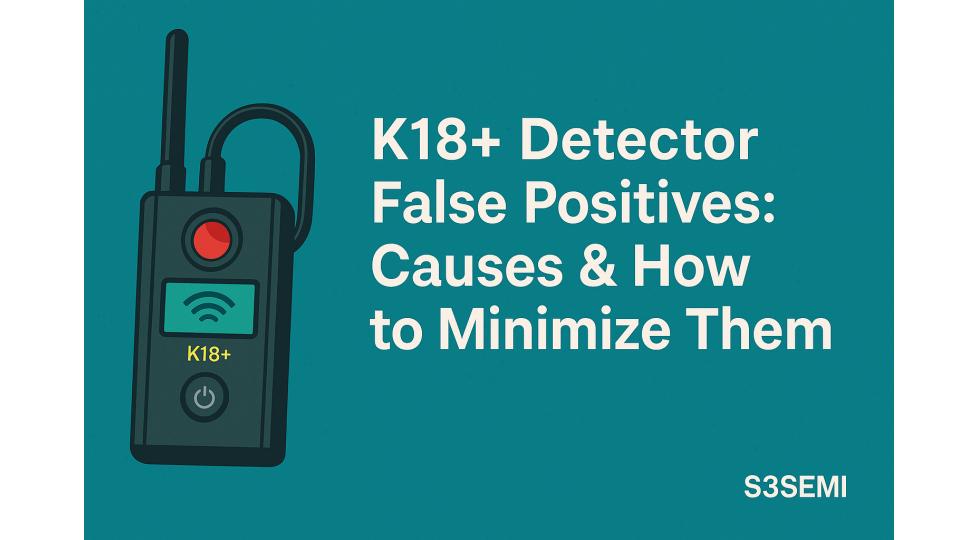The K18+ RF Detector is a popular handheld device used to detect hidden cameras, GPS trackers, and other covert wireless devices. It’s compact, user-friendly, and affordable, making it a favorite among consumers, security professionals, and travelers alike.
🕵️♂️🐞 K18 RF Bug Detector Deals ⭐⭐⭐⭐
🚨 However, many users report experiencing false positives—when the detector alerts even though no spying devices are present. In this article, we’ll explore why the K18+ can give false positives, common triggers, and how to minimize them for accurate scanning.
🧭 What Is a False Positive on a K18+ Detector?
A false positive occurs when the detector indicates the presence of a wireless signal or hidden device, but in reality, it’s reacting to a harmless or unrelated signal.
The K18+ is designed to detect a wide range of radio frequencies (RF), making it sensitive to various electronic devices beyond just spying equipment.
📡 Common Causes of K18+ Detector False Positives
Wi-Fi Routers & Access Points
- Wi-Fi operates in the 2.4 GHz and 5 GHz bands, which are well within the K18+ detection range.
- Proximity to a Wi-Fi router can trigger alerts even though it’s a legitimate signal.
Bluetooth Devices
- Bluetooth shares the 2.4 GHz band, causing interference.
- Nearby Bluetooth earbuds, speakers, or even a smartwatch can set off the detector.
Cell Phones & Mobile Networks
- Active mobile phones (especially during a call or data transmission) emit strong RF signals.
- The K18+ can mistake these for hidden transmitters.
Microwave Ovens & Appliances
- Microwaves leak some RF in the 2.4 GHz range.
- Household devices like cordless phones or wireless baby monitors can also trigger false positives.
RF Noise in Urban Environments
- Crowded spaces with multiple wireless devices—cafes, airports, offices—create an RF “noise floor”.
- The K18+ lacks advanced filtering, making it prone to false alerts in such environments.
Metallic Reflections & Signal Bouncing
- Metal objects can reflect RF signals, leading to spurious detections.
- This is common in cars, elevators, and rooms with metal fixtures.
🛠️ How to Minimize False Positives with the K18+
Here are practical tips to reduce false alerts and improve accuracy:
Turn Off Known Wireless Devices
- Power down mobile phones, Bluetooth gadgets, and Wi-Fi routers when scanning.
- If possible, move to an area with minimal wireless interference.
Use the Detector in Low-Signal Environments
- Perform scans in RF-quiet environments to get a baseline.
- If indoors, turn off or move away from wireless appliances.
Adjust Sensitivity Levels
- Start with low sensitivity and gradually increase as you approach potential hidden devices.
- High sensitivity can overwhelm the detector in noisy environments.
Use Camera Lens Detection Mode
- The K18+ has a visual lens detection mode (using red light reflection) that’s immune to RF noise.
- Combine RF scanning with visual inspection for better accuracy.
Understand the Signal Pattern
- Hidden devices tend to emit continuous or pulsing signals.
- Sporadic bursts from phones or Wi-Fi should not be mistaken for constant transmission.
Scan Methodically
- Move slowly and systematically.
- Sweep close to suspicious areas (vents, smoke detectors, electronic appliances).
⚠️ Limitations of the K18+ Detector
- Lack of Signal Discrimination: The K18+ cannot distinguish between different signal types.
- Wide Detection Range: Great for general detection but prone to false alerts in RF-dense areas.
- No Digital Readout: Lacks specific frequency or signal strength indicators.
🏆 Conclusion: Is the K18+ Reliable?
The K18+ Detector is a useful tool for quick scans, but it requires user awareness of its limitations. False positives are common due to its broad detection range and inability to filter out everyday RF signals.
By adjusting sensitivity, minimizing interference, and combining RF detection with visual inspection, you can significantly improve the accuracy of your searches.
For professional-grade detection, consider advanced RF detectors with frequency analysis and signal discrimination features.

